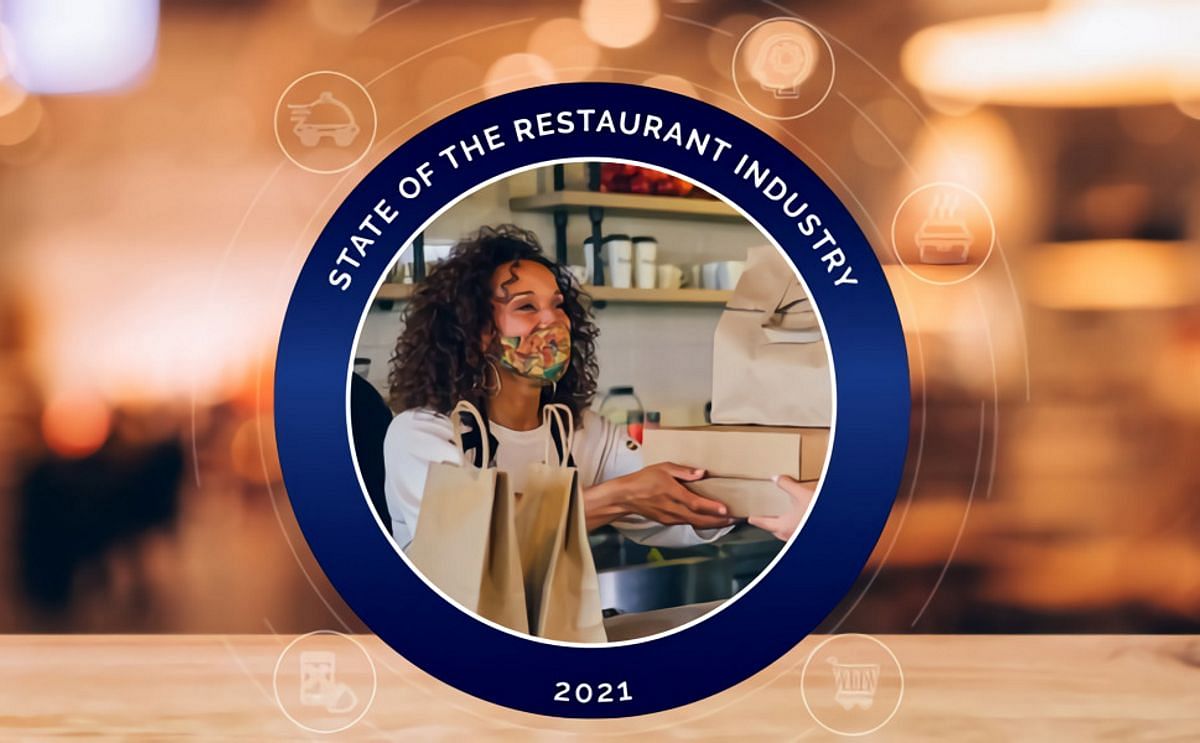The report explores crucial areas in which the pandemic forced restaurateurs to adapt quickly, adopting contactless technology, shifting most service to off-premises and outdoor dining, and adjusting labor levels and menus.
Primaire tabs
State of the Restaurant Industry report measures virus' impact on business

From 2019 to 2020, COVID-19 impacted the restaurant industry catastrophically, with sales plummeting 19.2%. According to the National Restaurant Association’s State of the Industry Report, 2021 sales are projected to climb 10.2%, though not nearly enough to recover from the steep hole caused by the pandemic.
The National Restaurant Association’s 2021 State of the Restaurant Industry report addresses the devastating impact of COVID-19 on the restaurant industry, documents the altered operational landscape, and captures consumer sentiment, influences and intentions for the coming months.
It also explores several crucial areas in which the pandemic forced restaurateurs to pivot and adapt, quickly adopting contactless technology, shifting most service to off-premises and outdoor dining, and adjusting labor levels and menus.
This will be the "year of transition and rebuilding," in the words of Hudson Riehle, senior vice president of the research and knowledge group with the National Restaurant Association, and it will take time before the industry gets back to pre-pandemic levels. Last year ended with sales $240 billion below the forecasted levels, with approximately 110,000 foodservice establishments permanently closed (and nearly three-quarters of those operators saying they would not open another restaurant).
Hudson Riehle:
"On a positive note, 2021 will be better than 2020 and for most [restaurant segments] the operational trend is advancing, not retreating. With 2020 being the worst year in restaurant industry history it will take some time to get back to pre-pandemic levels across a variety of operating parameters."
Based on data from responses to the Association’s survey of 6,000 restaurant operators across all industry segments, and a survey of 1,000 adult consumers, the report delivers impact data on sales and traffic, operational trends, food and menu trends, and workforce trends along with consumer purchase preferences and intentions.
The report offers a comprehensive and sobering look at the damage the pandemic caused the industry and millions of its employees nationwide. Several key findings:
- The restaurant industry ended 2020 with total sales that were $240 billion below the Association’s pre-pandemic forecast for the year
- As of Dec. 1, 2020, more than 110,000 eating and drinking places were closed for business temporarily, or for good
- The eating and drinking place sector finished 2020 nearly 2.5 million jobs below its pre-coronavirus level. At the peak of initial closures, the Association estimates up to 8 million employees were laid off or furloughed
Despite the grim numbers, pent-up consumer demand will create a mad rush once things get back to normal. In April 2020, the number of adults who said they don’t offer takeout as much as they’d like rose from 44 to 52%, though by December 2020, that number had settled down to 33%. In April, 83% of adults surveyed said they were not eating out as much as they’d like, nearly twice as many people (45%) who were asked the same question in January 2020.
It’s no question that as states and cities locked down throughout the pandemic — many for the majority of 2020 — that restaurant operators would come to rely more on off-premise experiences in the wake of their darkened dining rooms. Now, 68% of customers say that they’re more likely to purchase takeout or delivery now than before the pandemic.
Curbside pickup was also big, as "one of the least capital-intensive offerings" a restaurant could add during the pandemic (four in five family dining, fine dining, and fast-casual operators added curbside pickup during the pandemic).
And even as restaurant operators scrambled to get on third-party delivery apps (or expand their partnerships if they had not done so before), two-thirds of consumers still say that they preferred ordering directly from a restaurant.
Hudson Riehle:"For cerain operators, the availability of third-party option has had utility and in comparison, certain operators have elected to basically insource that delivery component, depending on your business model/physical location, and because the industry is so large and widle-varied, experiences are different."
The report offers extensive analysis on trends in several areas:
- Operations. Restaurants looked at a number of different ways to retain traffic and generate revenues. Operators focused on building off-premises business, especially in the fullservice segment, with roughly half of restaurateurs devoting more resources to expanding that side of their business since the start of the COVID-19 outbreak in March.
Adding curbside pick-up, inhouse and 3rd party delivery and if possible, drive-thru capacity, and upgrading takeout and delivery packaging were just a few of means they used to sustain business. Service styles also changed. In addition to the off-premises focus, a big portion of on-premises dining moved outdoors for as long as the weather permitted.
Tech adoption accelerated. Contactless and mobile payment options became crucial. Across all 6 segments—quickservice, fast casual, casual, family, fine dining, and coffee and snack—some 40% of operators said they added tech solutions to their businesses. - Food & Menu. With a slowdown in business, and on-premises dining restrictions, many operators reduced inventories, streamlining menus and developing menu items they could make well with smaller crews. Operators also began selling meal kits, bundled meals and even groceries—whatever customers needed and were willing to buy.
Customers sought out comfort foods, including burgers, pizza, pasta and Mexican specialties. The report lists best-selling items by fullservice and limited service venues. - Workforce. Before the pandemic, the restaurant and foodservice industry projected it would provide 15.6 million jobs in 2020, or 10% of all payroll jobs in the economy. But the impact of the coronavirus caused staffing levels to fall across all restaurant and foodservice segments, with restaurant employment below pre-pandemic levels in 47 states and D.C. The report emphasizes these three key findings:
- 62% of fine dining operators and 54% of both family dining and casual dining operators say staffing levels are more than 20% below normal.
- There are nearly 2 million fewer 16-to-34-year-olds in the labor force, the most prominent age group employed in the restaurant industry workforce.
- Restaurants got hit harder than any other industry during the pandemic, and still have the longest climb back to pre-coronavirus employment levels.
- Consumer sentiment and intentions. Despite the pandemic, pent-up demand for restaurants remains strong. Customers have become used to ordering takeout, but indicate they really crave in-restaurant dining experiences. Nearly 8 in 10 adult consumers said their favorite restaurant foods delivered flavor and taste sensations that couldn’t be duplicated at home, and 6 in 10 said restaurants are an essential part of their lifestyles.
But Riehle thinks attitudes will change as virtual restaurants become normalized.
Hudson Riehle:
"The one characteristic accelerated by the pandemic is focusing on points of access rather than locations."Not only is digital ordering technology a perk of the off-premise restaurant experience, but customers have come to expect it: one in four to-go customers say that app-based ordering would influence their choice of one restaurant over another.
"Virtual restaurants and ghost kitchens are an operational model that allows growth for the industry. That doesn’t mean they are the answer for all segments, but the pandemic really did focus operations into tapping into that off-premise potential."
And operators are stepping up to the plate: 25% of operators say they added technology to allow customers to order through apps and 40% of operators across all segments say that they added a contactless or mobile payment option since March.
Despite the fact that customers are now looking for the frictionless digital ordering tools, traditional restaurant experience still narrowly wins out. Nearly 64% of customers say that they would choose to sit in a restaurant with traditional table service vs. an experience with a tablet or smartphone ordering.
Hudson Riehle:
"Our research shows a clear desire among consumers to enjoy more on-premises dining at restaurants than they have been able to get during the pandemic. We’ve also found that even as the vaccine becomes more available and more customers can return to restaurants, they’ll continue to want the expanded off-premises options going forward. Both will continue to be key for industry growth."With COVID-19 still negatively impacting the success of the restaurant industry in 2021 (though the National Restaurant Association expects steady improvement as the vaccine is rolled out to more people), what will restaurants look like in the near-future? The pandemic brought many operational changes, from off-premise investments to technology upgrades and menu overhauls, and 68-74% of operators across all segments say that they plan to keep at least some of these changes.
The most likely COVID-19-related shifts that will mold long-term operations strategies include trimmed menus and the popularity of more off-premise options including meal kits and cocktails to-go: 35% of consumers and 53% of Millennials say they’ll be more likely to choose a restaurant if they can get an adult beverage with their to-go or delivery order. More than half of adults say they’d be likely to order a meal kit from their favorite restaurant in the future.
As the pandemic continues (and even beyond), comfort foods are a major selling point, with 33% of off-premise customers saying their food orders over the next several months will be influenced by if the restaurant sells their favorite comfort foods.
Hudson Riehle:
"The environment continues to change rapidly, but in the end, there will always be that underlying demand for meal solutions away from home."
Access the Report
The report is free to members of the National Restaurant Association (NRA) and non-member restaurant operators; other non-members may purchase it for $149.Access the report









